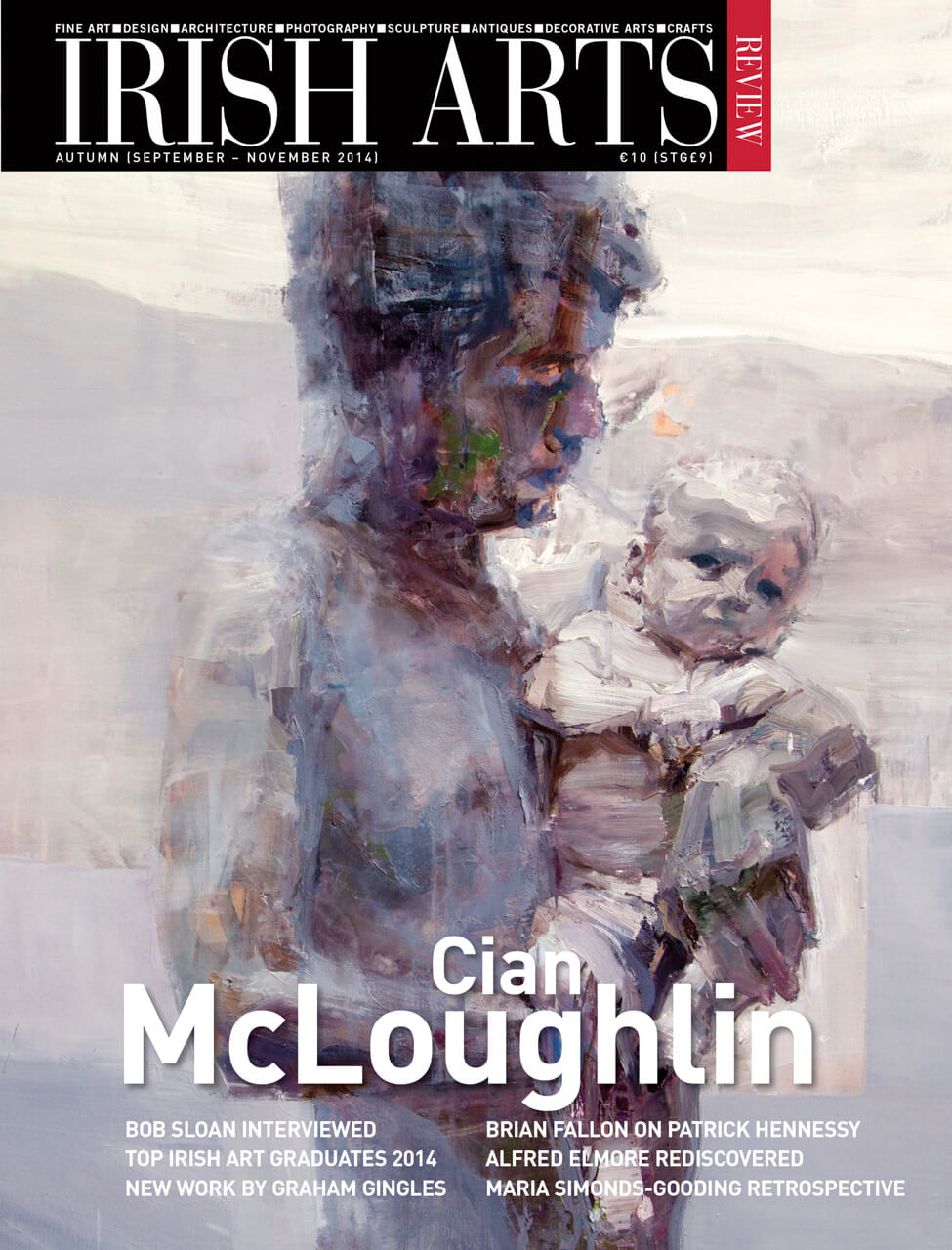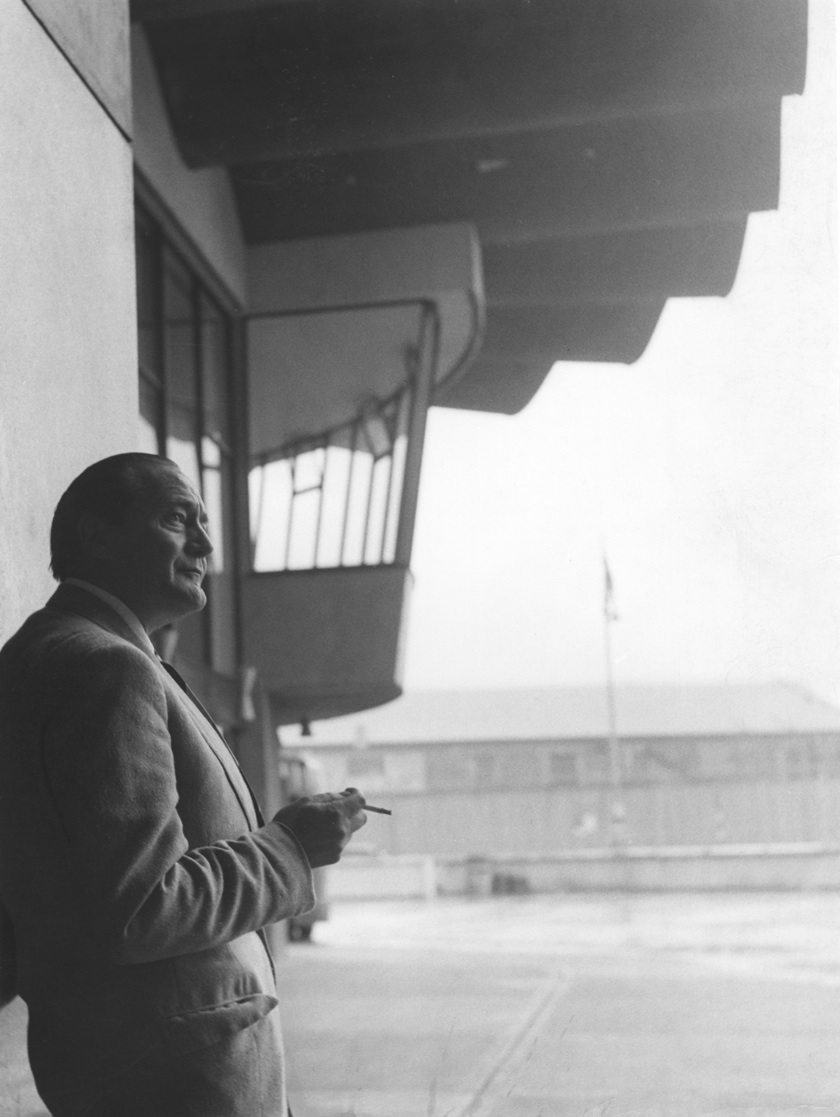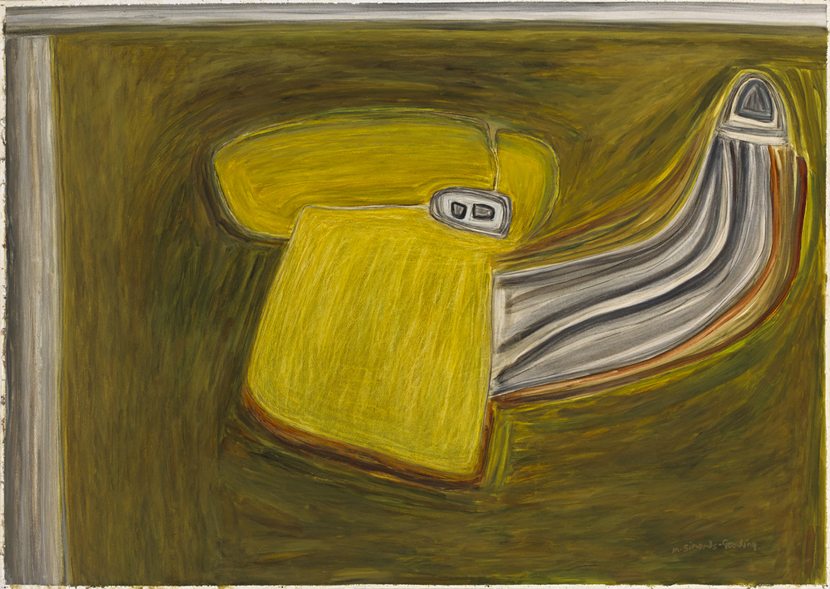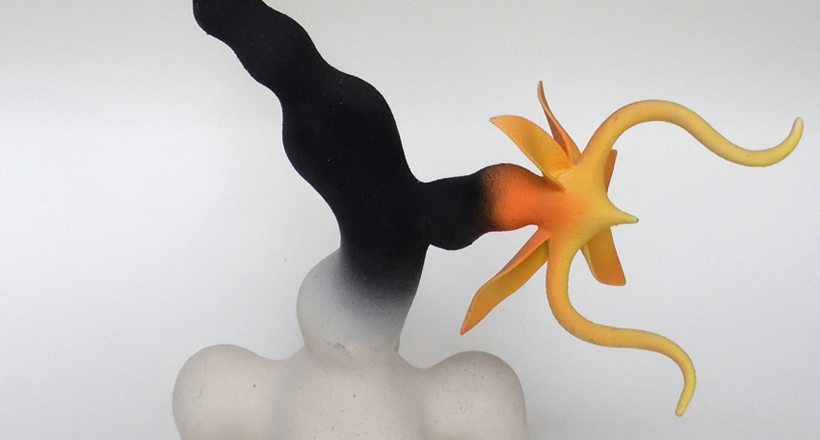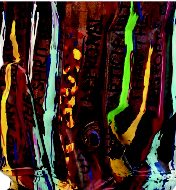
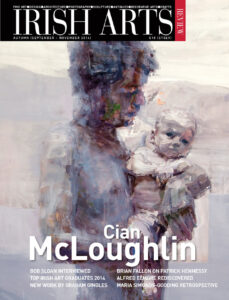
[slider_pro id=”82″]
From the IAR Archive
Reflecting on a career marked by invention and experiment, distinguished sculptor Bob Sloan tells Brian McAvera, ‘I find working in the studio as difficult as ever. Nothing comes easy’
BMcA: In the current R.U.A. show you have two heads, which are almost academic. Why?
BS: There’s a wonderful quote about Benny Goodman. When, in mid life, he was playing really well, he stopped blowing and started breathing. I think I’ve stopped shouting. There’s no need for it anymore. For me it’s possible, this last number of years, just to do what I’m doing, and find enough in that. I’m just drawn to doing those things (Fig 6) now. I used to think long and work fast but now those heads come out very slowly and the whole pace has dropped. If something catches my eye I do it, then go on to something else with a more contemplative pace and it’s extremely pleasurable.
BMcA: Four or five years ago, when I was in your studio, you were making sculpture from sheets of thin copper over which you poured pitch. You were also compressing and painting copper boilers. How did this work come about?
BS: It started with the Twin Towers collapsing, and guys jumping off it. I saw it on TV. It set off thoughts about America, so I started making compressed American flags as some form of metaphor for what I saw happening in America (Figs 10&11). I started looking at what the Americans felt had happened, how they saw themselves, how it was formed, how closely it adhered to what the Founding Fathers had said. It all coincided with me finding a scrap yard, which had a crusher. The owner readily let me use the crusher so I moved from the Twin Towers and people falling to what America thought of itself. What was being said didn’t even apply to the people who were saying it: talking about how they were all equal yet they had slaves.
I started using words. I’d squeeze the pieces and I needed to define the movement so I used lines of words, like type. Pure reaction! If things are there, sometimes they spark you. Once I crack a material I tend to drop it. I look forward to new machines, new materials: I am concentrating so hard on the materials and techniques that the content takes care of itself. Also, materials, like old objects, carry a history. Often I find myself referencing stuff that I did maybe thirty years ago. The older I get the less sure I am as to why I do what I do.
BMcA: You were born in Belfast during the War years, in 1940, to a father who was an upholsterer, and a mother who was a school cook. What are your earliest memories of growing up in Belfast, were you aware at all of the war, and was there anything that in retrospect coloured your approach to your art?
BS: When the 70th Anniversary of the Blitz was being remembered in newspapers and on television recently — I recalled being lifted into the back of a lorry as a kid. It was my birthday and I had been given a new pair of pyjamas, which had been made from a remnant. I remember being lifted up to my mother and taken away with other people. That would have been in 1941: my birthday was 10 April and it was the big Blitz in Belfast. At a later date I can remember being with other families in a concrete shelter in the street and straw being brought from the stables in Erin Street to sit on.
The folks on my mother’s side were carters: my great-uncle Rabbie Graham owned the business and I was always about the horses and the stables watching manes being plaited, horseshoes being made and horses being shod at the blacksmith’s in Chichester Street or at McKeown’s in Eliza Street. One of my great memories was of seeing the iron being put on a wooden wheel in Ardle’s yard in Tomb Street. It was magic! There were always harnesses about the place or being repaired at Jimmy the saddler’s in Lindsay Street. I can remember going up to the end of Apsley Street as the horses came back at the end of the day so that I could get a ride.
My father was an upholsterer. I realized recently, at Christmas time, that I learnt how to make a parcel, how to fold it, tying and knotting it; I got it all from my father. I’ve memories of my mother cooking and baking dough, marking, using the tools for making edges, using the fork to roughen up the mash top of pies, to seal pastry edges. My only connection with the country was that my brother and I were sent every year to the country, the Dromara hills. Some years ago a friend came back from England and we went for a drive and I suddenly realized that I knew this ‘space’: the house in Dromara had been on the slope of a hill. Across the road from the house was a tree, which I used to climb, and I made clay underneath it. When I revisited it, what had been a big tree in my imagination was a small tree. I was born in Apsley Street in Belfast, which was near the gasworks, near linen warehouses and the fancy box makers, the hem stitchers, the Ormeau Baths (we were just across the street from it), close to Donegal Pass. The noise of the coal being lifted out of the barges and dropped was constant. There was the smell of the gasworks: my mother told me it was a healthy smell and that it cured whooping cough! The hooters would be going to call the women and girls to work in the linen works, and people would be running like blazes to get in because if they were a minute late they lost
fifteen minutes’ worth of pay.
BMcA: Was there any crossover between the world of tradesmen and the world of ‘art’ – the Ulster Museum for example, or the early exhibitions of the Committee for Encouragement of Music and the Arts (CEMA)?
BS: Yes and no! I was greatly influenced by what I saw – experienced – when growing up – the working of a wide variety of materials and techniques, but I doubt if these would have been accepted by the art world as having any artistic value. Certainly I didn’t make any connection between what I saw and the art world. I was given wax one Christmas, modelling wax, obviously bought locally, and I had paints. My brother’s a much better painter than me. If I went to a museum as a child, it would have been to see the (Egyptian) mummy (at the Ulster Museum), and that was it! My father was very handy with a paintbrush in terms of painting the house; graining was a big fad then.
Also we had illustrations on the wall, a ballet dancer I remember, some photographs. My granny had a beautiful Japanese print of a mountain. I now realize it must have been Mount Fuji and she had a wonderful collection of china dogs and slush-cast ornaments. Uncle Willie had greyhounds including one very good one later sold to England and I remember when talking to granny the greyhound came up and I found out that it was called Bold Emmet! I said, where did that name come from, and it turned out that there were two slush-cast ornaments about Robert Emmet. And this was a Protestant working-class house. I was born in Donegal Pass but mother’s family came from the Markets, which then as now were predominantly Catholic, so possibly it was fashionable to have the Emmets.
It was stone carving, clay modelling, plaster casting and eventually after a couple of years life modelling and that was it
BMcA: Do you think that the almost complete lack of a sculptural tradition in the North was an advantage for you?
BS: I don’t think so. It’s debatable one way or the other. The sculpture we had here, by FE McWilliam, Rosamund Praeger, Mercy Hunter’s husband George McCann who had worked as an assistant to Henry Moore, I wasn’t aware of. By the time I came across FE McWilliam’s work I had started art. There was a slight idea that I might do engineering. The brother was an apprentice engineer who became a draughtsman. I studied engineering drawing at school and of course Annadale (school) produced a lot of artists. Ken Jamison (future director of the ACNI) was a cracker. He had a breadth to him and he was interested in theatre and music. T P Flanagan told me he had gone with him to Greece to look at the sites and Ken would go back to the hotel and make notes! Wilfie Stewart, who was the Head of Department, was easy-going. The parents had to be spoken to in terms of me going to art school. I didn’t have any great skill at art in school. I remember working in Stewart’s Cash Stores on the Lisburn Road, in the vegetable shop, and on the back of brown paper bags I’d draw the trees that were opposite. Jamison opened the whole thing up. There must have been something as Jamison came and spoke to the parents and argued the case that I should go to art college. As you know, he’s a very tall man; he had to duck his head to get into the house. He was a heel striker, so when he walked the heels of his suede shoes took a beating. When he left, my father said to my mother: ‘What do you think?’, and she said ‘Not a great ad. He hadn’t a heel to his shoes’!
BMcA: When you went to the Belfast College of Art (1959-63) you studied Sculpture. What predisposed you? Who were your lecturers and co-students?
BS: I don’t honestly know! It certainly wasn’t the teaching!! The art course in sculpture would have been recognized by a 19th-century student: drawing from antique statues, modelling casts from Michelangelo’s David – his nose, or ear which you copied in clay. We learned how to build an armature, mix plaster, make a mould, but nothing else. The first metal sculpture I made was a lead cast. I got the lead from the stained-glass studio and melted it in a pot there. Nobody knew anything about welding or metal casting! It was stone carving, clay modelling, plaster casting and eventually after a couple of years life modelling and that was it.
It was great because the students were lively; TV was starting to appear, and weekend supplements. John Luke I came across in Annadale: a pile of old magazines, probably The Studio, with articles by John Hewitt in them. He was the first local painter I came across, then Basil Blackshaw (Ken Jamison and he were contemporaries) and TP Flanagan. I probably learnt more from the students, as happens today. There was an energy there. We formed a students’ union because some girls came in, in jeans, and were sent home. This was in 1960. That’s the level of openness. It was quite a strange atmosphere. The guy who taught ceramics, Hemingsly, was interesting. Three great painters – Romeo Toogood and Tom Carr taught there and John Luke but he was a very shy man. I did stone carving there, modelled directly in plaster – pushing the envelope – and made some things from old pots. I made a ‘Three Graces’ using old steamers, the ones with the holes, tying them together with pieces of wire. That wouldn’t have gone down too well: assemblage. Even then I was using strange mixtures of materials in a Hepworthesque piece, a musical deity, using glass instead of string. I actually used pipettes filled with dust. That didn’t go down well either.
He said to me there comes a time when it’s best for a young artist to be outside an art college and I think that’s where you are now
BMcA: You went to Central St Martins in London in 1963-64 at a time of major ferment in art, and especially in sculpture, in London. What were your experiences there?
BS: The attraction was London. Nobody was going across. People had gone to Leeds. Indeed John Breakey had gone to the Slade but most went to England to do teacher training. Romeo Toogood had gone to the Royal or the Slade a generation or two before. I wanted to apply to the Slade and Tom Carr, who had been there, said that he would mention me and so I got an interview for the Slade and bombed! I was very wound up. Then, eventually, I went again to London by myself with a portfolio and went to the Central. Kesselman, the Head, looked at my portfolio and seemed to be interested and called in a colleague; I later learned that this was William Turnbull. He said to me there comes a time when it’s best for a young artist to be outside an art college and I think that’s where you are now. But I’m happy if you want to come here. Fees? I said. He said buy a ticket for an evening class and you can come along any time. It was eye opening. I saw everything. In the mornings I’d go to the Cork Street galleries: Waddington’s, Marlborough, Gimpel Fils. I saw all of the commercial shows and then I’d go to the Whitechapel, which was magic then. I saw Gorky in the Tate. I was going to the Tate more so than the National Gallery or even, I’m sorry to say now, the British Museum but the Tate – seeing the Picasso sculpture, Degas’ Little Dancer – that was a revelation. That’s what it was about. In the Whitechapel they were showing Americans like Rauschenberg and the modern British sculptors like Caro and Paolozzi. The Museum of Mankind was an eye-opener. I was aware of Inca sculpture’s influence on Moore and I saw Paolozzi’s choices in the Museum of Mankind.
Turnbull and Warren Davis were the two guys in the Sculpture Department at Central. There was a freedom, an encouragement: nothing was impossible. I remember, in Belfast, sanding down a stone carving and I needed another bit of emery paper and had to go and ask for it. In Central you walked in, the materials were there, and you used them. One nice thing was when a technician said to me ‘I’ve just broken down one of your clay pieces: would you mind showing these guys how you built your armature?’
BMcA: You didn’t return to Belfast until 1965. What did you do in the meantime?
BS: I didn’t complete the full year at Central: no money left! I was even doing part-time jobs but not making enough so I got a teaching job. It was a bit strange, as my Belfast qualification – I’d done a one-year teacher qualification in the Tec – was not recognized in the UK. I had a job teaching in a primary school in Tooting and Mitcham, up Balham way. I wasn’t there for a full year. Eventually the secondary school there, Gorringe Park, offered me a job as an art teacher but still paid as if I was unqualified. My parents used to send me food parcels with butter and bread in them and at one stage I was walking from Putney to Gorringe Park, which was an hour-and-a-half’s walk. Surviving as an unqualified teacher in London? I thought this was a nonsense so I came back home for the Easter holidays in 1965 to introduce Vicky (his future wife) to my parents, put in an application for a job in Lisburn – I was going back to London when I received a letter, asking me for interview. I phoned them to say I wouldn’t be able to attend but the Principal said I’d already got the job. I think I may have been the only applicant!
In London I had met my wife who was working in County Hall. She fed me and kept me warm. I don’t know where the money came from but I had bought a scooter, which released me from the pressure of getting to work. I finished the term at the secondary school, got married in London, and came back here. I was then making enough money to rent a studio (a room at the top end of Bridge Street in Lisburn: a basement with a grille). I retained the studio until I moved to Antrim to be Head of Department in Parkhall. I worked there for about three years. I had started exhibiting when I was in Lisburn, in the old CEMA Gallery in a show called ‘Young Irish Art’. When I was in London I had gotten very into film. There was a programme on a commercial Scottish TV station run by John Grierson who was the first to use the term ‘documentary’. I saw documentaries, commercial, and non-commercial movies like Orpheus Rising. I think it may have been because of this interest that when I was back in Ireland I started producing wall pieces with a sense of time to them: a series of tableaux, boxed, some of them quite small and in Windsor and Newton boxes. Then I did bigger pieces. When I was teaching in Lisburn I went to evening classes to learn how to weld. I had also gone to learn how to cast aluminium in a school on the Ravenhill Road. It was a one- or two-day course. With aluminium you can make something in polystyrene and then cast it in aluminium. When I moved to where I am now, in 1969, I closed the Lisburn studio and started working in the sheds around the place and I was casting in aluminium. I was making them first in polystyrene, then going down to the Ritchie Hart foundry, a commercial one in the Short Strand. I was at Parkhall from 1971-74. The tableaux works were in the ‘New Generation ’65’ exhibition and in the ‘Ulster Painting’ (1968) shows. They were all reliefs. In 1974 there was a joint exhibition at the Arts Council gallery with Vernon Carter which mainly consisted of very colourful drawings for sculpture, produced between 1971 and 1974.
BMcA: In 1974 you joined the Ulster Polytechnic (now the University of Ulster) as a lecturer, mainly in Foundation Studies, though it is well known that anyone who wanted practical help in sculptural techniques needed to come to you! How did this happen?
BS: Each lecturer had a mixed group of students. We were tutors to groups of about twelve and we each took an area. I started with fibre glass, then it was a wood workshop, and then in the late 1970s I built a foundry and did that to 1982. Then I had a sabbatical and I was getting involved with paper, which I made myself. There was clay, plaster and metal casting in the foundry. Everybody on the Foundation course came to each area offered – there was fashion, photography, creative design, 3d design, painting and so forth. Everyone spent, I think, two weeks in each workshop. It was an introduction. After the first term, they chose an area for the second term. Of course that’s when the Foundation course was in Jordanstown. It was idyllic. There was freedom in every way. We could make decisions immediately about content if new.
At the Poly the site-specific stuff was happening for me. There was a massive amount of space, including the old PE area – a big hall that was never used. I was playing around with floor pieces: chalk dust, sheets of steel, aluminium, copper. I had access to the place so I could go up anytime – weekends – anytime! Big site-specific floor drawings, some of which were shown in the 1982 Arts Council show. I was also making pieces that incorporated welding. That was the show that was blown up!
BMcA: In 1977 you had both Installation and Performance pieces at ‘Documenta 6′. Can you describe them?
BS: ‘Documenta’ was a development from the Poly stuff. I was quite interested in Systems art and in the use of chance (Fig 12). There was a good library at the Poly. I was using dice as part of the drawing practice and was much taken by what was happening in America. I was drawn to the politics of it, the stuff that (it seemed) couldn’t be owned.
For ‘Documenta’ I started off thinking in terms of divisions, how and why society is divided up, and I thought of building a wall. It struck me they had a bigger wall than we had! Then I realized that it was about accepting the divisions, which were often self-imposed ones. People themselves make the divisions. There were two pieces in the show. In the first room, the one that Beuys used with the Free Open University, which was circular and had a corridor entrance to it, I used sandbags and built a wall that gradually diminished in size, running down the centre of the hallway and then, at the open end there was a sandbag and white stones. People had the choice of walking in one of two ways. If they went one way they were barricaded in, so they had to go the other way, step over the stones, and go into the gallery where other people’s art was. Outside, in the parkland, an artist had built a sculpture by sinking a one-kilometre pipe into the ground! There were a series of pathways around it. Using fluorescent tape (the kind the police use in relation to accidents) I built a network of tapes. For the first performance they were raised a few inches off the ground with sticks, and a colleague called James King (who I had been working with in the Poly doing joint projects with students) would try to make sense of these obstacles. His background was community drama. He used the tapes as if he were a tightrope walker. We had rules: absurd rules, self-imposed rules on how to negotiate the framework of tape. I don’t see that ‘Documenta’ was of any real importance to my career as a sculptor. Being there was certainly an experience!
BMcA: I suspect that participation in international workshops such as the Foundry Workshop in Baltimore in 1980, or the Washington Sculpture Conference in 1980, would have been seminal. What was the impact of events like these?
BS: Even before that workshop and conference I had gone to the 10th International Sculpture Conference in Toronto in 1978 where I saw demonstrations of casting and spoke with other sculptors who suggested I needed to increase the capacity of my existing small foundry. Talking to the instructors I found that they were so sure that it would be easy for me to do. I arrived down to the workshop and they proceeded to make a furnace, burners and the like: they just did it! That got me into bronze. A grant from ACNI enabled me to do this. Meeting sculptors in Washington in 1980 that were living from their art was a revelation. It became apparent that they were committed, serious and happy to spend money. I had loathed the idea of spending money, having little. Then it dawned on me that I had built a foundry (it was rebuilt well before Baltimore) and that I’d have a good studio. I was going to buy what I needed. It was a breakthrough in my outlook: everything was possible. The job at the university meant that I had a bit more money, so Vicky suggested you have an art account, and we’ll have a joint account for the family.
On the strength of the aluminium pieces that I’d been making I got the commission to make the Downpatrick piece (which was unveiled in 1982). In America I had seen big sculpture. America is littered with large pieces of steel: they use it because it’s there! I saw work by Richard Serra, Di Suvero, Nancy Holt, went to the Governor’s State University Sculpture Park. There was the whole idea of assistants to sculptors! It broadened my horizons and my thinking.
Since my college days I have always been politically aware – to the left, and have helped where I could with a political party but I have always been wary of Art as propaganda
BMcA: Looking at the catalogue of your first Arts Council solo show in 1982, one is struck by a combination of surrealist elements (early Moore, Giacometti, early FE McWilliam) in pieces like The Poet’s Premonition of Impending Doom, the Picasso influence in Couple 1 (Fig 8). Assemblage seemed the dominant means. As the Troubles started (officially) in 1969, how far were these elements a response?
BS: Not at all. Since my college days I have always been politically aware – to the left, and have helped where I could with a political party but I have always been wary of art as propaganda. I don’t know where those pieces came from. The only way that the Troubles had a bearing was in the idea of chance, of Happenings. I became less precious. The Troubles moved us out of Belfast: that was the major thing!
BMcA: A long time ago now, in a lecture at the Fenderesky Gallery, you remarked on the elements of magic and subversion in your work: ‘If someone is walking along a path, you shift them off the path, onto another one, without them even realizing it’. Can you tell us what you mean by reference to some of your works?
BS: If you were to look at the ‘Chair Series’, they started from a comment Ian Hill made (referencing Matisse) about some art being like a comfortable armchair. So art equals comfortable chair. My response to Ian was ‘I’m afraid my art is a bit like the Princess and the Pea – uneasy – if likened to an armchair I suspect there’s something lurking in the cushion, about to bite me in the arse’. This then led to Hitchcock’s Chair (Fig 5) in which, between the legs, comes a steam train with billowing smoke, which is actually hair.
Brian McAvera: You’re very much a one-man band: self-contained, a large studio complete with pulleys and hoists. What is it, at this stage of your life that you want to achieve?
BS: I wouldn’t know how to answer that. I’ve never sat down and tried to place something in terms of a career. I know how to build a career but I’ve never been taken by it. I’ve always been conscious of getting my work into places where it not be forgotten, museums, large collections, being mentioned in surveys. I dislike exhibiting, even dislike going to them now, especially to openings. I’m quite happy to keep on doing what I’m doing. I please myself as to when and how I want to do something. I’m not self-satisfied. I find working in the studio as difficult as ever. Nothing comes easy.
All images ©The Artist.
Brian McAvera is an art critic.
